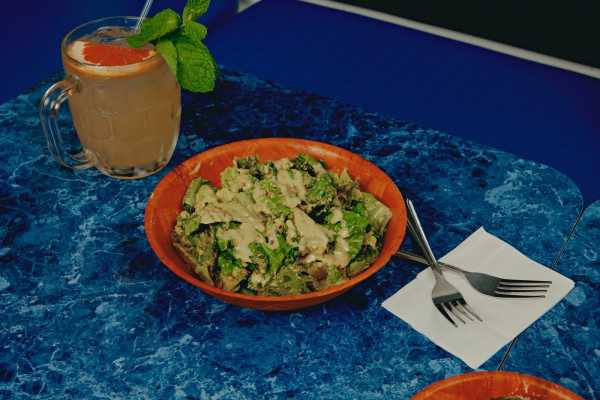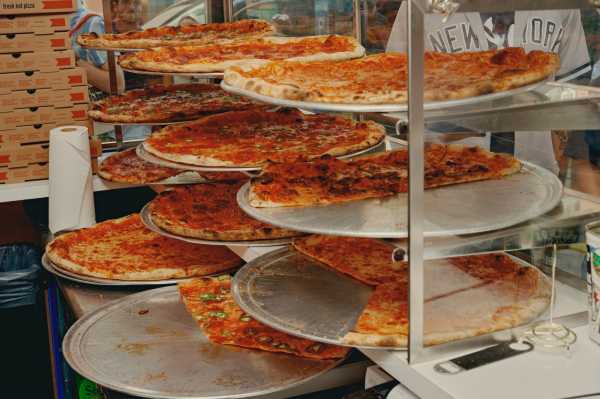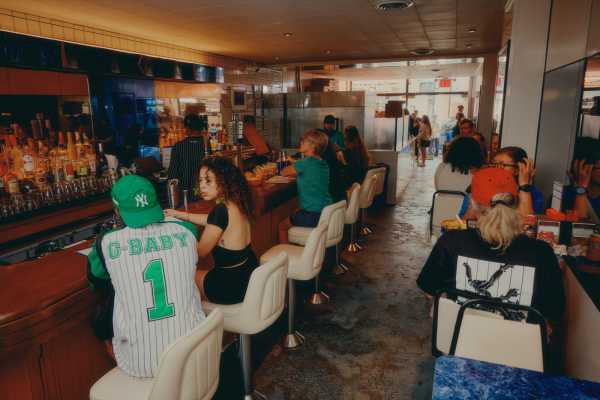
Save this storySave this storySave this storySave this storyYou’re reading the Food Scene newsletter, Helen Rosner’s guide to what, where, and how to eat. Sign up to receive it in your in-box.
Every conversation about pizza is a trap. Is thin crust better than tossed crust? Is pineapple an acceptable topping? Should tomato sauce be applied cooked or raw? Is it a margherita if the mozzarella doesn’t come from a buffalo? Is it O.K. to pass on eating the crusts? Is a starter-risen dough better than one made with commercial yeast? Is a coal oven better than a wood-burning one? Does California have its own style? Does Chicago-style deep dish even count as pizza? Many people claim to have answers, because everyone believes they’re a pizza expert—including actual pizza experts, who are nightmares. But there are no answers, only conflict, and the digging in of heels. The infinite variety of pizza beliefs is so universal that it slips into something almost Jungian, a window into the self and the shadow. The pizza of your childhood, the pizza of the place you consider home, the pizza that awakened you to the fact that pizza could actually be gastronomically magnificent—each is the best pizza in the history of the world, because it’s the history of your world. Tell me what you think is a perfect pizza and I’ll tell you who you are.
At eight-thirty on a recent Saturday night, the line for slices outside of Scarr’s Pizza—in a new location, which opened in July, across the street from the now closed original Lower East Side spot—ran up Orchard Street to the end of the block, where it turned west down Hester Street and ended in a churning knot of people joining and leaving, unsure whether the wait, and the pizza at its terminus, would actually be worth it. “Worth it” is one of those slippery concepts which plague our commodified, optimized lives. The poor soul at the end of the hundred-odd-person queue will pay $3.75 for his slice just like everyone else, with the added cost of an hour or so in line. But then there will be the slice itself: a large, tapering wedge, maybe dressed with rounds of pepperoni, or studded with sultry mushrooms, maybe just a pure and simple triangle of sauce and cheese. And it’ll be a Scarr’s slice—a legendary slice, an if-you-know-you-know slice, a slice that earns heart-eyes emojis when you post it on Instagram. Because Scarr’s is where you go if you want a slice that’s good—like, really good, like, “best slice in New York” good. Whatever “best” means. Whomever it means it to.

A spacious dining room in the back serves cocktails and pizzeria classics; the Caesar salad, with a cashew-based vegan dressing, is one of the best in the city.
Is it worth it? I don’t know how to answer that question, and I’d be skeptical of anyone who claims that they do. All pizza is relative, New York pizza doubly so. Millions of words have been written and uttered on where to get a great slice in this city, ranking the best of the best, mapping optimal itineraries for crawls and tours. People have built entire careers on stating, with utmost confidence, that one pizzeria’s strikingly good slice is two iotas closer than another’s to the Platonic ideal. It makes sense that pizza is a topic of obsession: like all things of great simplicity, the smallest variations in approach have an outsized effect on the end result.
Here’s what I will say: any list of great pizza that leaves off Scarr’s shouldn’t be trusted. The restaurant’s slice is excellent, just this side of faultless. The crust is fantastic, light and a little bit tangy, with a sturdy bottom that gives over almost immediately to a springy interior. There are no puddles of grease, no bald patches of dough, no vexing bubbles or stray scorch marks. The whole thing has admirable structural integrity, succumbing neither to sag nor to sog. The sauce is bright and fresh—it can land a little bit flat, but it’s nothing that a hit of hot pepper can’t perk up. I can also tell you this: if you go to Scarr’s in the middle of the week, on the early side of the lunch rush, maybe while it’s raining a little, you’ll find that the line stretches just four feet out the door, so the question of whether it’s “worth it” doesn’t factor at all.
The restaurant’s owner and founder, Scarr Pimentel, grew up in Hamilton Heights, in a sprawling Dominican family; as a teen, he landed a busboy job at the celeb-magnet Nolita restaurant Emilio’s Ballato, where he started learning the basics of turning flour, yeast, and water into dough. He moved on to pizzerias—Artichoke Basille’s, known for its gargantuan slices, and Lombardi’s, arguably the birthplace of New York pizza—and began to refine his own sense of pizza perfection. Scarr’s Pizza opened in 2016, in a narrow sliver of a space with brown wood-panelled walls, molded Formica booths, and kitschy late-seventies ambience. It was a deliberate aesthetic, both a play to nostalgia and a subversion of it. Pimentel, a Black Latino man making moves in the overwhelmingly white pizza world, wasn’t paying homage to the pizzerias of his youth; he was claiming them.

The slices at the new Scarr’s are virtually the same as at the old, which is a thrill, and a relief.

The promise of Scarr’s, as a restaurant, is perhaps sixty per cent pizza and forty per cent vibes.
The original Scarr’s was a classic New York pizza shop, serving classic New York pizza, except for all the ways it wasn’t. The ingredients were organic. You could buy a can of Bud Light, but you could also get a bottle of natural wine. There was no pork in the kitchen—Pimentel doesn’t eat it—and a portion of the menu skewed plant-based and vegan. The pies were thoughtful and deliberate, not high-speed, high-volume gut bombs. Pimentel is an exacting sort of person, which is a good quality in the world of pizza: when he couldn’t figure out exactly the right blend of flour for the crust of his dreams, he started milling his own, a fresh batch daily, in the restaurant’s basement prep area. The slice shop’s Orchard Street location, and its whole vibey gestalt—aesthetic deliberateness, quasi-healthfulness, nerd-level gastronomic rigor, plus a tiny bar and dining room that felt a little bit like a secret—made it a default for the hip and artsy habitués of the lower end of the Lower East Side, an area that’s since become saddled with the name Dimes Square. Social-media buzz began to build. Bon Appétit declared it the best slice in the city. The lines were long, and getting longer.
In pizza, as in all things, trends come and go—everyone’s freaking out about sourdough crusts one minute and Detroit-style rectangular pies the next. When Pimentel opened Scarr’s, many of the city’s most lauded pizzerias were sit-down affairs that served whole pies: coal-fired, Italian American-style at old-school spots like Lombardi’s and John’s of Bleecker; minimalist, jewel-like Neapolitan pizzas from Una Pizza Napoletana; and cheffy, creative “New Brooklyn” pizzas at places like Lucali, Roberta’s, and Emily. Now, for some reason (credit the slumping economy, a collective wistfulness for a New York City that once was, or the success of Scarr’s itself), we are living in the golden age of the slice. It is the fundamental unit of New York pizza: a cheap, hot meal for a city short on time and money and space, consumed while standing, a food shovelled-in more than eaten. At places like Scarr’s (and similar new-wave slice shops, like L’Industrie and Mama’s Too), it is treated like a form of art.
Pimentel has held the lease on the new space for a few years but took a while figuring out what to do with it. There were plans for an all-vegan pizza shop, or for some sort of partnership with Danny Bowien, then of Mission Chinese. In the end, Pimentel’s move was straightforward: make it a bigger Scarr’s. (He retains the old space, and has made some noises about turning it into an omakase counter.) The new restaurant is three times the size of the old one, and the whole mood is different: the basement-brown has been ditched in favor of a palette of glossy white, black, and royal blue. The effect is still retro, still nostalgic, but for a different time and place: somewhere swankier, more grown-up. This makes some narrative sense: Pimentel is now a king not only in the pizza world but also in the worlds of fashion and art. He’s collaborated with Nike on a run of Scarr’s-branded Air Force 1s. He did a pair of T-shirts with the high-end streetwear label Carhartt WIP, and made pizza with the tennis star Roger Federer in a promo video for Uniqlo. Pizza obsessives regularly pay pilgrimage to Scarr’s, but Pimentel also knows the value of playing to an audience of scenesters and social-media obsessives—people who like a good restaurant but adore a cool one.

The Hotboi pizza (center)—with beef pepperoni, jalapeño, and hot honey—has arguably become Scarr’s signature.
The slices at the new Scarr’s are virtually the same as at the old, which is a thrill, and a relief. But if you slip past the counter business at the front of the shop—and, depending on how long the line is, and how hangry the liner-uppers, this can draw a little heckling—you’ll find yourself in a spacious full-service restaurant, with blue-and-black booths and a long mirrored bar. (You can walk in, if things are slow, or else book a table on Resy.) The serviceware is still pure pizza-parlor kitsch: pebbled plastic water glasses, checkerboard wooden salad bowls, and not a piece of porcelain in sight. Everything is served family style, and you eat off of white paper plates. To me, a person fuelled by restaurant nostalgia, this is all charming, but I can’t quite get a handle on what it’s supposed to add up to: A family pizzeria? A serious sit-down restaurant? The hottest room in town? I don’t think it really matters: the promise of Scarr’s, as a restaurant, is perhaps sixty per cent pizza and forty per cent vibes.
On a recent visit, at dinnertime, it felt like a party, tables spilling over with revellers of uncommon stylishness, calling out greetings from table to table and lining up to play at one of the dining room’s two video-game consoles. On another visit, outside of prime time, it was half empty—I wandered back holding a paper-plated slice from the counter and settled in at the bar. As at the old Scarr’s, the back room has a different menu than the slice shop, with cocktails, natural wines (including a fizzy red Lambrusco, the ultimate pizza wine), fancy house-made soda, and a roster of non-pizza pizzeria classics with a Scarrsian spin. The Caesar salad, developed with the chef Gerardo Gonzalez, remains one of the best in the city, with a cashew-based vegan dressing that has a bracing degree of funk and brine and, instead of traditional croutons, ultra-crisp, golden-brown fried bread crumbs—a transformative textural variation that I wish more alt-Caesars would adopt. Appetizer portions of eggplant parm, meatball parm, and chicken parm (on the old menu, they were served as sandwiches) could easily serve as entrées; the meatballs are soft as a sigh, though too gentle in flavor, and tossed in a tomato sauce that, like the one on the pizza, is bright but slightly bland.
But the pizza, of course, is the point. The table-service menu offers smaller, more human-scale versions of the pizzas sold up front. Sized to feed maybe one and a half people, they are fired to order and emerge from the basement kitchen steaming hot, with tall, puffy edges that remind me of (but, let me be clear, lest the pizza experts figure out where I live, I am very much aware are not) Neapolitan pies, with their billowy outer rings and calderas of sauce and cheese. They use the same ingredients as the slice-shop pies, but the proportions make a difference. The pie that has arguably become Scarr’s signature, the Hotboi—beef pepperoni, jalapeño, and hot honey—is sharper and friskier in its smaller form. Whenever I’ve waited in the counter line at Scarr’s and ordered a square slice, I’ve regretted it. (This style has a thicker, airier crust than the tossed pizza; like focaccia, the pie is baked in a pan doused in olive oil until the sides and bottom are deeply bronzed.) At the slice counter, I found that the squares were always a little dry, a little heavy, and I’d end up wishing I’d gone for the classic triangle. Ordering a square pie in the dining room, where it also comes out smaller, hotter, and ethereally light, I regretted nothing. The DJ Clark Kent, with chicken sausage and slices of fresh garlic, is a new candidate for my favorite Scarr’s slice. Is it the best slice of pizza in New York? You’ve got to answer that for yourself. ♦
Sourse: newyorker.com






